The alfalfa weevil (Hypera postica) has developed resistance to the most common, effective and affordable insecticides used to control its damage (pyrethroids), complicating and threatening current management (Figure 1).
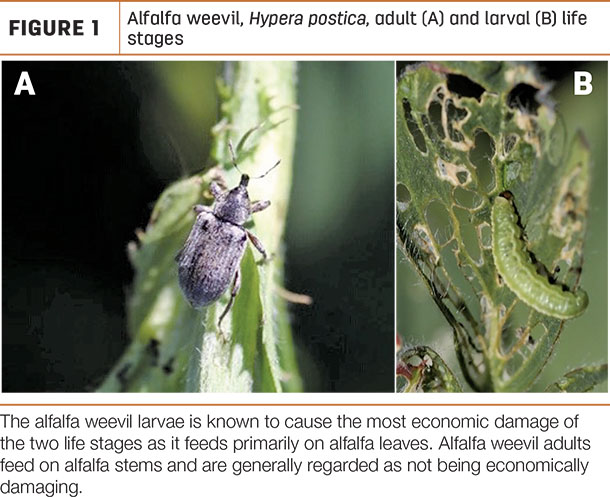
It became a pest when its host, alfalfa (Medicago sativa), started to be cultivated in southwestern Asia about 2,000 years ago. After alfalfa was first grown in the U.S., in the late 1800s, the alfalfa weevil was quick to follow, appearing near Salt Lake City, Utah, in 1903 (called the Western strain); Yuma, Arizona, in 1939 (the Egyptian strain); and Maryland in 1952 (Eastern strain). It is now the key defoliating insect pest of alfalfa nationally.
After years of exposure, insect populations can and do develop resistance to insecticide toxins, making them ineffective. Per the Insecticide Resistance Action Committee (IRAC), insecticide resistance is “the heritable change in the sensitivity of a pest population that is reflected in the repeated failure of a product to achieve the expected level of control when used according to the label recommendation for that pest species.” This change in the genetic makeup of insect populations can produce alarming and costly consequences when materials are no longer effective.
Pyrethrum, the “precursor” to pyrethroids, was derived naturally from chrysanthemum flowers and used as a natural insecticide as early as the first century A.D. Beginning in 1968, synthetic versions were produced by agricultural chemical companies, yielding active ingredients like bifenthrin, cyfluthrin, cyhalothrin, cypermethrin, deltamethrin and permethrin. Pyrethroid insecticides are commonly used in forage crops because they are effective, economical and have good human toxicity profiles.
What does pyrethroid resistance mean to alfalfa producers?
Many products with trade names such as Baythroid, Grizzly Too, Mustang-Maxx, Paradigm, Pounce, Proaxis, Silencer and Warrior II have active ingredients in the pyrethroid class. With growing issues of pyrethroid resistance, these products will no longer effectively control alfalfa weevils. Larger alfalfa weevil populations cause greater forage loss, and their management is becoming more difficult and expensive.
How do we know resistance to pyrethroids has developed?
The bad news is: Highly resistant populations to pyrethroids have now been found across the Western region. The good news is: Not all areas face problems (yet). Research funded by the USDA NIFA AFRP and the National Alfalfa Forage Alliance has helped quantify the problem. In the laboratory, we coat glass vials with a range of concentrations of the pyrethroid active ingredient and then expose field-collected larvae to the vials. Figure 2 illustrates how resistant and susceptible populations respond.
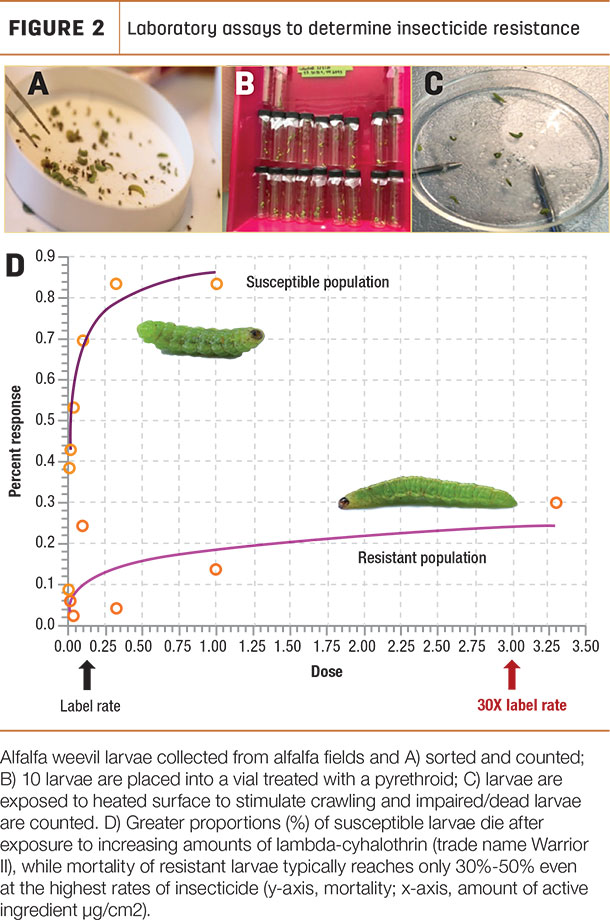
For susceptible populations, as soon as the concentration of pyrethroid increases a little, nearly all of the larvae die. For resistant populations, mortality never gets higher than 30% to 50%, even with high concentrations.
What happens when you spray resistant weevils infesting forage alfalfa?
Insecticide trial results in Figure 3 illustrate the problem.
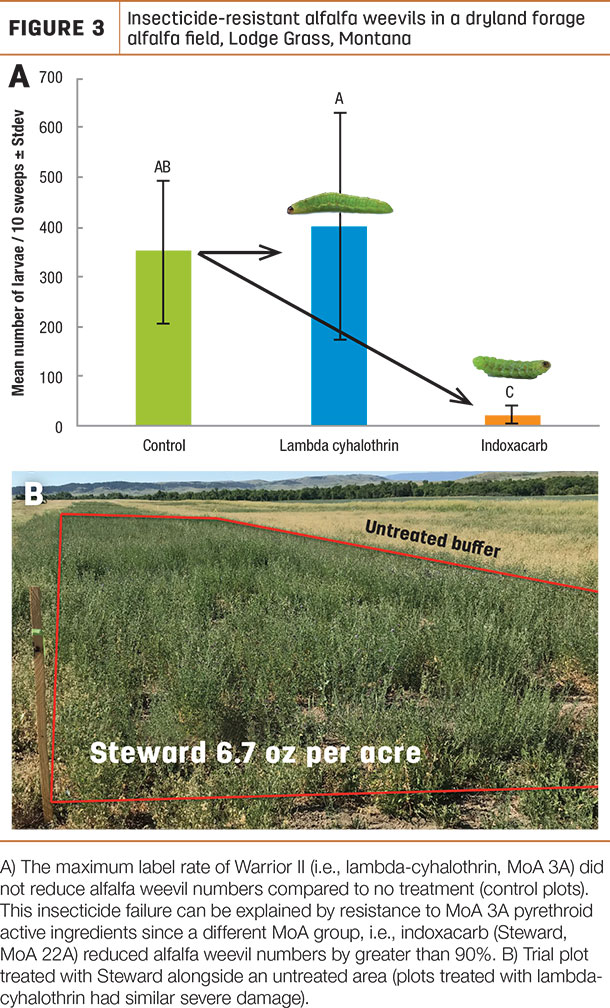
A common pyrethroid insecticide like Warrior II only kills about half of the larvae, and the other half keep on feeding. We know they are resistant specifically to pyrethroids (regardless of the product) since an insecticide with a different mode of action, Steward (MoA 22A), kills more than 90% of the population, much like pyrethroids did before resistance developed (or continue to do in susceptible populations). Thanks to collaborating extension personnel across the Western region and the hard work of graduate students who conducted hundreds of laboratory bioassays, we have a better picture of regional resistance to pyrethroids. We have found highly resistant populations in every Western state we surveyed so far (Arizona, California, Oregon, Montana, Washington and Wyoming).
What can producers do?
1. Watch for early warning signs in your area, notably slipping effectiveness. Maybe in the past you used lower label rates and they were effective, but higher label rates are now necessary and control may even continue to slip. Multiple applications are applied with little to no control – the population is now highly resistant. Small insecticide “strips” applied using commercial, ATV or backpack sprayers can be informative when compared to an untreated strip. Apply a pyrethroid product in comparison to Steward and an untreated check, and sample larvae one week later – if the number of larvae in the Steward-treated strips are reduced by more than 90% relative to the untreated strips, but are not similarly reduced in the pyrethroid strips, resistance has likely developed (Figure 3, for example).
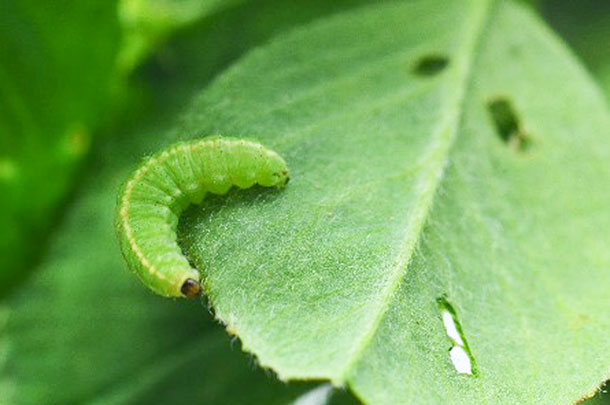
2. Know your mode of action (MoA) groups and use them for resistance management. An insecticide MoA group is listed on the label of the insecticide product. Insecticides are grouped into MoA groups based on how they affect target insects. For example, pyrethroids (e.g., Warrior II) are in the MoA group 3A (VGSC modulator). Indoxacarb (e.g., Steward) is in the MoA group 22A (voltage-dependent sodium channel blockers). Even if you use different products, if they have the same MoA (e.g., Mustang Maxx and then Warrior II), you are still selecting for resistance. To reduce or limit resistance development, it is important to rotate MoA groups between years.
3. If a producer is in a pocket of high resistance – in these areas, pyrethroid use will stop simply because they are ineffective (happening already). Currently, there is only one viable and effective alternative, Steward, MoA 22A. However, repeated use of Steward puts this MoA at risk of resistance developing. Following principles of Integrated Pest Management (IPM) (scouting, thresholds, alternative management strategies where possible) is exceptionally important. (See additional points below.) At some point, pyrethroids may become effective again, but a rotation would need to rely on them minimally.
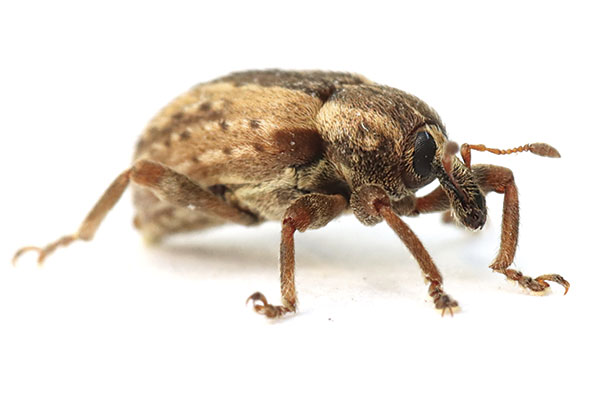
4. If a producer is in an area with no or moderate resistance – the key to slowing the spread and worsening of resistance is to reduce the use of the toxin (i.e., pyrethroid products) that selects for the resistant weevils. Use the concepts of IPM:
- Survey your field and apply insecticide only when economic thresholds have been met. Avoid routine use of pyrethroids including early applications mixed with herbicide; wait to know whether threatening populations are present before spraying.
- Rotate the control tactic. No treatment (threshold has not been met), early harvest to preserve yield and kill larvae, and rotate the MoA insecticide. (Currently, this means rotating Steward and a pyrethroid with the non-insecticide options). Do not apply Steward or a pyrethroid more than once every three years. If weevil populations carry over to the regrowth after harvest and require control, use the same MoA if multiple applications are required in the same season (i.e., maintain year-to-year rotation of MoA).
- Optimize the effectiveness of insecticide applications to kill weevils “heterozygous” for resistance. These are individuals that have only one copy of the resistance gene and typically can be killed more easily than individuals with two copies. Apply higher label rates, optimize timing and use adjuvants that improve coverage and persistence.
Ian M. Grettenberger is a cooperative extension specialist at the University of California – Davis. Email Ian M. Gretteberger. Erika Rodbell is a graduate student at Montana State University. Madison Hendrick is a graduate student at University of California – Davis.
Kevin W. Wanner is an associate professor of Entomology and Extension Specialist at Montana State University. Email Kevin W. Wanner.










